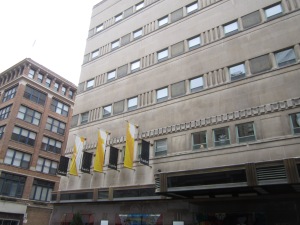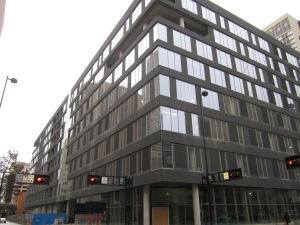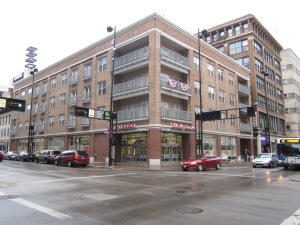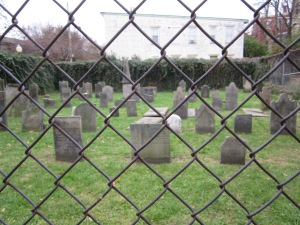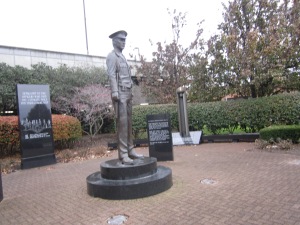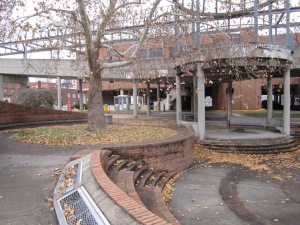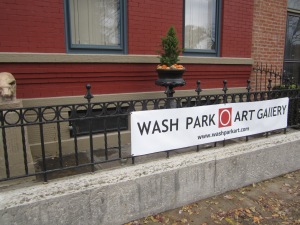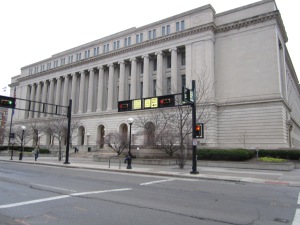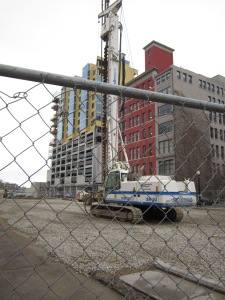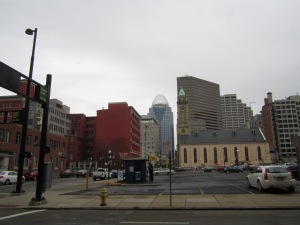With a college degree in history, I tend to walk through life collecting data without even realizing it. For me, our built environment – the offices and churches and courthouses, our stores, our homes – all of them together are perhaps the most obvious and important record of the way that we have come, what we value as a society and how that changes over time.
One of my earliest childhood memories is going downtown with my grandmother in the early sixties, a time when ladies still got dressed-up to go to town, little girls wore white gloves and everybody took the bus. Grandma had an appointment with Miss Toomy, her regular saleslady at Gidding-Jenny’s Department Store on Fourth St. and afterwards she took me to lunch on Pogue’s Ice Cream Bridge where she let me order a Coke with my grilled cheese.
How much has changed in the course of one short life. My grandmother died in the late Eighties, soon to be followed by Gidding’s, Pogue’s, and many of the ideas about how and where we buy what we need. The Miss Toomys of the world no longer exist. Going shopping downtown was permanently and forever disrupted by the development of the highway system, our shift to the suburbs and multiple cars in the driveway of every American dream.
Nothing lasts forever – and so the pendulum swings back, slowly at first and then faster as it gathers momentum. Gas prices increased and the internet happened – that information super-highway that has already in its first decade permanently and forever changed everything in its wake, like the bomb in Hiroshima. Cities are popular again with young professionals and as every generation has to find something to rebel against, they have rejected their parent’s automobile-based lifestyles in favor of walking, biking and public transportation again.
How do you plan a city when they never stand still? Where does a community invest its hard-earned resources so that we will continue to generate positives returns – not just economic returns – but the kinds of returns that really enrich lives and make more people want to live here – decisions that should outlast not just one generation (I’m writing this from Italy, the window over my desk looking out at a fifteenth century church) – but many, many generations to come.
What concerns me when I think about urban development these days is that the vast majority of our new buildings seem to be constructed for planned obsolescence, you know – unimaginative, utilitarian structures that go up on-time and under-budget, very efficient kind of stuff designed to pass quickly through the committee approval process. “Mixed-use,” “pedestrian promenades,” “street level retail space,” and a lot of emphasis on the number of parking spaces in the publicly subsidized garages, those seem to be some of the significant catch phrases of late. But does anybody really want to spend time in those spaces unless they have to? Are these just features the architect tacks onto an office tower to hit the hot spots in the most recent city plan?
Maybe the scariest thing about changes in development is where the incentives lie for the developers. When John Emory built the Carew Tower in 1930, he did so planning to own it for the rest of his life, so he built it with a pride that is reflected in the materials, the details, the art.
Emery had approached the bank to underwrite financing, but the bank did not share his vision and declined the loan. In spite of the advice of his financial consultants, Emery sold all of his stocks and securities just before the Crash. Had he left his money tied up in the market, he would have lost everything. But instead, the project continued as planned and became one of the city’s largest employers.
On the other hand when Eagle Realty, a subsidiary of Western & Southern, built the 41 story Queen City Square (now called Great American Tower) – they never owned the building, not for one second. They purchased the bonds issued by the Port Authority to finance the building as an investment for their insurance company, made their big money on the development fees and and have the master lease on the property (management fees). The public owns the 1,000,000 sf Class A office structure and we’re the ones who have to figure out what to do with it if big corporations cease to dominate the economic landscape after the master lease to W&S expires. But why worry? Less than two years after completion, Western & Southern has already listed part of the property on the market hoping to attract some big institutional investor to our mid-tiered market. Besides, the building will be fully paid-off from the 30-year property-tax abatement (Yes! 30 YEARS!) that pays down the bonds even if we do get stuck with a white elephant.
Nothing lasts forever and nobody ever guesses right about the future a hundred percent of the time. But before we invest any more time, money and energy in private-profit real estate developments, maybe we should sit down together as a community and have a long, thoughtful discussion about what we want our future to look like. After all, we’re the ones who are paying for it.
